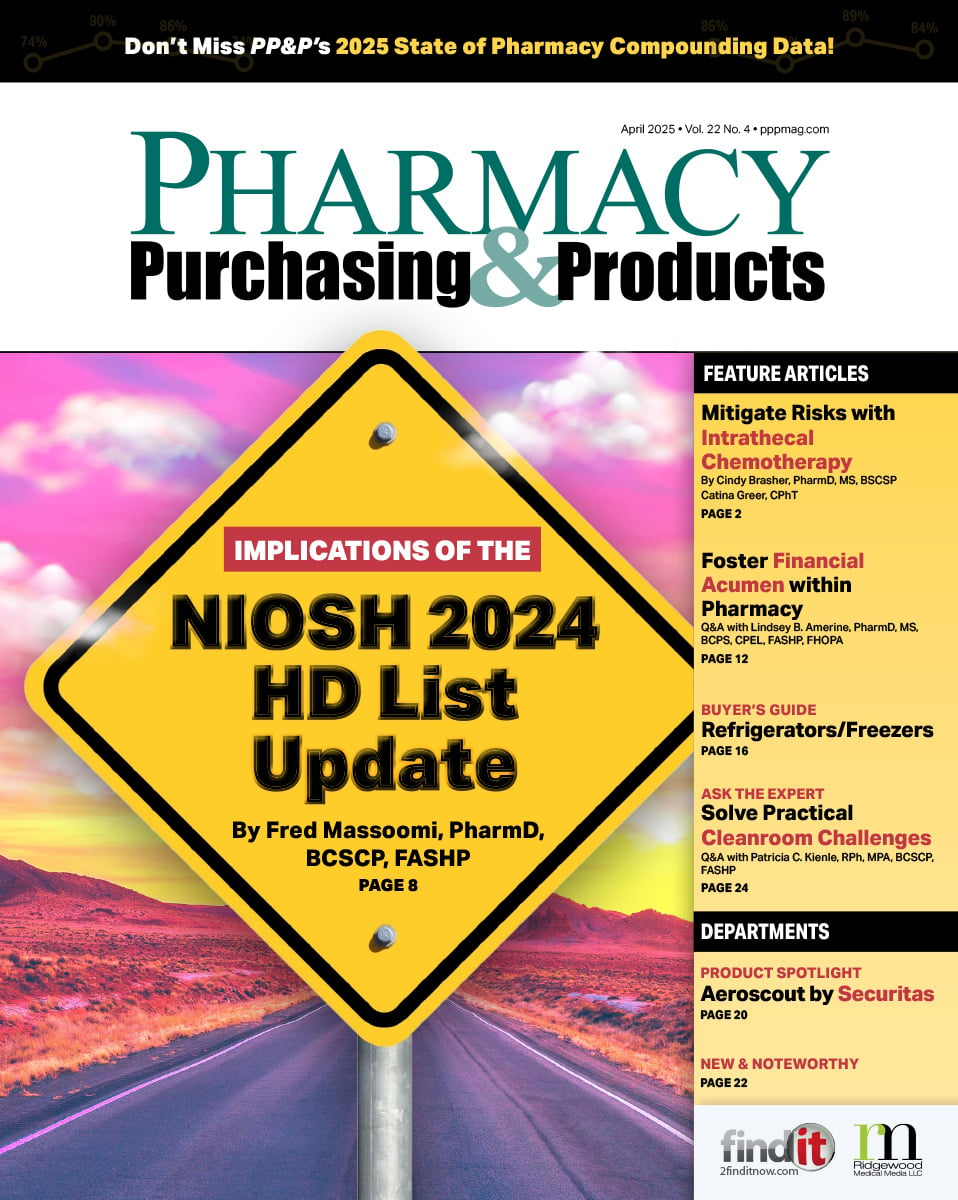- Show Menu
- Contact Us
- FAQs
- Reader Service
- Survey Data
- Survey Winners
- Testimonials
- Upcoming Events
- Webinars
- White Papers
Develop a Unit Dose Packaging Strategy
Pharmacy’s goal of providing all medications to patients in bar coded unit of use often requires a combination of strategies, including purchasing medications from the manufacturer in unit of use, purchasing medications in bulk and repackaging in-house using manual or automated methods, and contracting with a third-party repackaging service. Because medications may not be available from the manufacturer in bar coded unit of use, many organizations employ a combination of strategies to achieve their unit-dose goals.
Panola Medical Center (PMC) is a 112-bed facility in Batesville, Mississippi, offering emergency care, surgery, radiology, women’s health, labor and delivery, pediatrics, cardiopulmonary services, physical therapy, cardiac rehab, pharmacy, sleep, primary care, and a wound care clinic. Our daily census is approximately 40-50 patients, with the majority receiving care at PMC West, our 57-bed, acute, inpatient psychiatric center, which serves adult and geriatric patients receiving psychiatric care or chemical dependency treatment. PMC’s busy ER averages 60 patient visits each day, and the pharmacy operates weekdays from 7am to 5:30pm and on weekends from 7am to 3:30pm.
The health system utilizes automation including CPOE, BCMA, a pharmacy information system, and ADCs. In addition, we repackage oral solid medications in-house using an automated unit-dose packaging machine. The machine uses software that connects to the in-house drug library, as well as third-party software, which supports NDC, lot number, and expiration date searches and verifications. Repackaging medications via automation ensures patients receive the correct medications, when needed, in unit of use.
Developing a Unit Dose Packaging Strategy
Our medication procurement strategy is to purchase as many medications as possible in unit of use and then repackage the remainder in-house. Five years ago, PMC repackaged medications using a manual process. At the hospital where I previously worked, unit dose packaging machines were utilized, so I saw an opportunity to significantly improve safety and efficiency at PMC by moving to an automated process.
We purchased the same machines that I had a positive experience with in my prior position. At that time, the bar coding feature was simply used for charge code purposes, but soon we moved to BCMA using NDC codes, which significantly improves safety from the time the medication leaves the pharmacy, until it is loaded into the ADC, and then administered to the patient.
Choosing a Vendor
When choosing a vendor, it is important to consider the level of customer support the vendor offers. Our vendor provides access to a support helpline to walk us though any challenge that may arise with the machines, whether mechanical or software-based. In 5 years, we have only had minimal troubleshooting calls; each time the vendor addressed our concerns thoroughly and quickly. Two of the cases involved the spooling mechanism being offline, and both were caused by user error, the technician bumping or inadvertently moving the mechanism. We are extremely satisfied with the high level of customer service and follow up our vendor provides.
The Repackaging Process
The medication repackaging process is straightforward but requires that the technician follow specific steps. After cleaning the machine, the technician obtains the tablets or capsules and enters the required information into the repackaging software system. The pharmacist confirms that the information has been entered accurately prior to the initiation of packaging. The tablets or capsules are added to the rotator and then go through the machine, which separates them into unit dose and packages and seals them. To ensure medication integrity, thermal paper is used on the front and lightproof packaging on the back of each unit. The software generates the label, including all of the necessary information about the medication, such as generic name, brand name, NDC number, lot number, expiration date, manufacturer, and PMC’s charge code. Repackaging typically occurs in multiples of 10, for ease of inventory. Thereafter, the pharmacist checks the products again for accuracy. The software also generates the label for oral liquid medications, which are measured into amber unit-dose cups and sealed using a crimping tool that presses the caps on the cups, or are drawn up into an amber oral syringe and labeled with a flag label generated by the packaging software.
Although the process is not overly time consuming, the required time must be factored into workflow requirements, especially if an organization has staffing challenges. It is critical to proactively pull and repackage commonly used medications before bins are empty. Our strategy is to identify bins that are almost empty and repackage and refill them prior to the end of the shift.
Staff Training
Although operating the unit-dose repackaging machines is fairly uncomplicated, thorough training for new technicians is critical to ensure proper technique and efficient in-house repackaging workflow. It is important to explain the purpose of the repackaging process, how the machines work, proper technique, what information must be included in the labeling, and the cleaning and maintenance process for the machines. For example, it is critical that the technician perform the steps in the correct order, that they verify that there is enough tape for the job, and that the plates are clean. We use a checklist to ensure the technician performs all the steps in the correct order.
We have found that it is similarly important to train the pharmacists to operate the machines. As a small facility, when a technician is off or calls in sick, it may become necessary for the pharmacist to occasionally repackage medications. At least twice daily, one of our technicians delivers medications to PMC West. While the technician is out, the pharmacist may have to perform the unit dose repackaging. In addition, a pharmacist has had to lend a hand with technician responsibilities when a technician is out sick or on maternity leave. In a small operation, cross-training is especially critical to keep up with workflow.
Maintenance
In our experience, the repackaging machine has been low-maintenance and user-friendly. To keep it operating as intended, proper maintenance is required. Technicians clean the machines before and after each use, and we perform all regular maintenance recommended by the manufacturer. The manufacturer publishes recommended yearly maintenance and replacement parts. We perform maintenance checks at the end of the year based on these recommendations to ensure all the parts are still working as intended and make the recommended replacements.
Addressing Challenges
As mentioned earlier, some medications are simply not available on our contract for purchase in unit dose, and some medications are available in unit dose but from an economic standpoint it is not feasible or reasonable for us to purchase in unit dose. In those situations, it makes sense to purchase in bulk and repackage.
Repackaging fish oil capsules has presented challenges, as some types are too large for the repackaging machine. When attempting to repackage these gel caps in the machine, capsules would sometimes break during the sealing process, which introduced an unpleasant smell throughout the pharmacy. For a short period of time, we were able to purchase smaller fish oil capsules that could be run through the machine, but they are not consistently available. Fortunately, this problem was solved when a unit-dose packaged fish oil was made available for purchase.
Benefits Realized
Safety
Ensuring medication safety is PMC’s top concern. The automated repackaging machines’ bar coding capabilities ensure patients receive the correct medications. Moreover, in the event of a medication recall, we can run reports by NDC to locate those medications and remove them from stock and ADCs. In addition, Tall-Man lettering helps guard against look-alike/sound-alike errors.
Tracking Capability
The unit-dose repackaging machines’ reporting capabilities allow us to track the volume repackaged each month; over the last 6 months we have repackaged approximately 100 capsules and tablets each day.
Cost Considerations
Cost is always a consideration when purchasing medication. Although our mandate is to purchase as many medications as possible in unit of use, we also consider purchasing certain medications in bulk and repackaging in-house, especially if there is a significant cost difference between the two methods of procurement. If the cost of a unit-of-use medication is slightly higher than the cost of a bulk medication that we could repackage in-house, it makes sense to purchase the unit-of-use product. However, if a unit-of-use medication costs significantly more than the bulk medication, we may purchase in bulk and repackage it ourselves. Contracted items change, which affects costs; therefore, there is no final rule or specific algorithm for determining when to purchase in unit of use and when to repackage. These decisions are most often made on a case-by-case basis.
Conclusion
Providing medications to patients in bar coded unit of use is a common activity, but also a critical responsibility. To achieve this goal, organizations must develop a strategy that may include purchasing medications from the manufacturer in bar coded unit of use, in-house repackaging, and outsourced repackaging. When adopting packaging automation, it is critical to choose a vendor with excellent customer service, ensure staff is properly trained to use the machines, and that regular maintenance occurs.

Josette F. Nelson, PharmD, is the director of pharmacy at Panola Medical Center in Batesville, Mississippi. She received her pharmacy degree from the University of Mississippi School of Pharmacy.
SYSTEMS SCOOP
- CPOE: PatientKeeper
- ADCs: Omnicell's AcuDose-Rx
- BCMA: PatientSafe Solutions
- Pharmacy Information System: McKesson's Horizon Meds Manager
- Oral Solid Unit-Dose Packaging System: Medical Packaging Inc's Auto-Print II Packaging System
- Unit-Dose Bar Code Labeling Software: Medical Packaging Inc's Pak-EDGE
- Unit-Dose Packaging Software: First Databank
- Ancillary Medication Labeling Printer: Healthmark Services' Pharmacy Accessory Label Printer (PALP)
Like what you've read? Please log in or create a free account to enjoy more of what www.pppmag.com has to offer.








